Forge World Diaries: OC1
|
|
On 03/13/2012 at 06:31 PM by Michael117 See More From This User » |
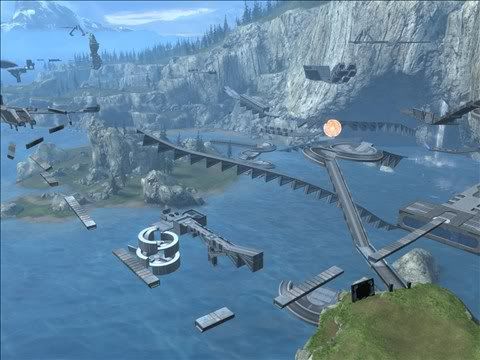
As much of it as I could fit into one shot. Center and right are all mongoose set pieces, and far left is a platforming section
Update: Hi Pixlbuddies! This was originally posted on 1UP.com last October, but I've rewritten much of it and added some fresh pics to make this the best version it can be as I finally bring it to you. These diaries are the reason I began blogging. Hope you find it insightful, entertaining, and devoid of incineration hazards.
Forge is a game mode, introduced in 2007's Halo 3, that allows the player to alter and customize multiplayer maps. Myself not being as big of a participator in competitive multiplayer, I wasn't interested in the feature and only spent a few minutes inside the editor back in 2007 when it was introduced. However, when 2010's Halo Reach came along the game provided a Forge with expanded options that I could finally sink my teeth into, most notably the expansive blank canvas map Forge World. Even though the tools and spaces are meant to be used for creating Halo multiplayer maps, I wanted to use the tools and space to build uniquely non-Halo gameplay in the setting, which could be played single player, or with another person.
In this diary I will describe how the process of messing around in Forge World for the first time taught me some things about level design, and most importantly about myself. This will be quite a bit longer and more intensive than my previous blogs as well, mostly because it deals with something I'm very passionate about and love analyzing. I'm not here to boost my ego, and certainly not tell you I'm good at anything. I want to study the good, bad, and ugly of what I create, learn from it, and progress. Never go backwards or stagnate. I take the art of level design and general game design pretty seriously and since I'm at the beginning of this journey (to becoming a level designer) I know I have an entire body of knowledge to build and experience to gain. Using Forge World helped me to build a little confidence and made me realize I have at least a few basic raw skills and talent that I never knew I had, and can add onto as I learn.
I hesitate calling any of my current creations a level (it feels a bit arrogant and obnoxious to do so) but I will call it a level for sake of consistency and to avoid an internal monologue over whether anything I create is good enough to have a flashy name. For now I organize things in the most simple way I can. This first map is called Obstacle Course 1 (OC1), creative right lol?
When I first went into the map and started work on it I had no idea what kind of tools were available, how I could use them, how the budget worked, or simply how the control scheme worked when editing. I spent a while figuring the control scheme out first as well as looking at all the assets (building blocks, bridges, ramps, etc) one by one. I erased plenty of ideas and creations during this time. Nothing was sticking and I didn't really have any inspiration or refrences in mind.
I don't have formal training or experience in any way, so my definitions and lingo will be things I assume to understand, and ideas that just come out of my mind naturally. If I need to be corrected or educated on anything, I will be more than willing to accept legitimate knowledge and guidance from anybody reading these diaries. Now, inspiration and reference are essential to level design because they give you a base vision or feel to interpret, manipulate, or extrapolate. To me inspiration is being inspired by something you experience in life and letting your imagination explore it, and reference is taking specific references to that world or experience and letting them influence your creative process of making your level(s). My inspiration for OC1 came in the form of the experience I had during Portal 2. I was inspired by the fact the I was in a first person shooter but never had to shoot anybody. I was inspired by the mechanics, physics, puzzles, as well as the explorative and adventurous feeling the game gives me. The second I beat Portal 2 I knew I wanted to make games like Portal. One specific refrence I had in mind was my favorite aspect from Portal 2, the aerial faith plates.

So I had inspiration and references, but even though I said earlier that I take level design pretty seriously, I wasn't taking OC1 very seriously. I didn't draw up any plans, envision how things would turn out in my head, or anything. For this whole level I literally built as I went. At any given moment, I looked at the assets I had, studied the landscape, and on the fly tried to come up with fun ways to build around everything. This creative process won't get you far if you hope to be a professional level designer. A good designer should be able to effectively pre-plan, collaborate with their teammates, and organize their thoughts and intentions with a map long before they are at a computer making their ideas happen. I however don't have a team and I just wanted to prove to myself I could make something that my friends and myself would want to play. Like an ODST Helljumper falling through the atmosphere in a drop pod, I jumped feet first into the soup and asked questions later. This is the spawn point for OC1.

The spawn area I established in the "Collesium" section of Forge World. There are two Warthogs lined up with a jump between two cones. There are two origin spawn points designated by the holographic Spartans, and the other two points in front of them are respawn points. I have two DMRs hovering near the vehicles because I like grabbing one before I begin. Weapons serve no purpose in this level, but the DMR is my favorite weapon so I always have it on me, wartime or not
The aerial faithplate was only one refrence in my mind because the majority of this level is actually a mongoose track and when it comes to this aspect of the design my inspiration was a rollercoaster. I wanted the track sections to be smooth, fast, to change elevation, and allow the player to experience them at full speed as often as possible. I wanted the difficulty of everything to be fairly easy and consistent for experienced Halo players. As for non-Halo players, I concede that this level might be incredibly difficult and frustrating due to the fact you will not only have to learn to use Halo mechanics, but use them consistently on each obstacle in challenging ways. My criteria for being easy and consistent also included the following: No need to rely on lucky bounces or glitches, just use a few mechanics in the right way each time and you will succeed. As I present new sections of the level in this diary I will explain the mechanics necessary to succeed. Along this mongoose track I wanted to add plenty of large jumps to make things exciting. At the spawn zone there are fixed cones aligned with the mongeese, and you drive through the cones at full speed to take the first plunge.

The first plunge. Land on the ramp below, drive through the mancannon, and take the first mancannon launch. Landing area is just beyond the large orange kill ball
It took me a long time to get the ramp alignments the way I needed them. First I needed to spend some time figuring out how far to set the initial ramp away from the jump zone where you drive between the fixed cones. I have to make sure that the ramp is a proper distance, angle, and depth. Reason being, to ensure that when you're putting the pedal to the floor at the spawn point, you will consistently have enough speed everytime you play the obstacle to not only make it across the first plunge but to also hit the ramp at the right angle to maintain your momentum. Controlling the depth the player falls is important as well because I have to make sure you fall far enough to make it fun, but not be an unfair danger to the mongoose and player.
This kind of scrutiny is present in every single addition to the map and with every new jump, asset added, or obstacle implemented, I had to playtest it over and over to make sure it is not only fun but is also consistent, fair, and as balanced as I could manage. In OC1 I quickly tested everything 7 times or so, and if I was able to accomplish the mechanic at hand exactly the way I needed it to be every one of those attempts, I would consider it to be safe to move on and keep building. I would also try to approach the obstacles in various ways to anticipate a player playing in a different way than myself, and if I found an alternate solution or a different angle to take a jump at, I tested it as well to make sure it worked the majority of the time. If something didn't work or wasn't fun it always got tweaked or simply cut altogether. There were times when I would come back to the game the next day and erase an entire nights worth of work because it simply wasn't good enough.
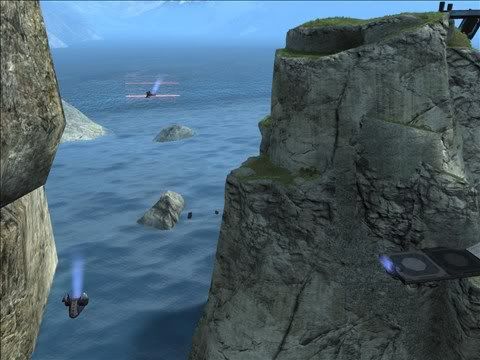
Aerial faithplate imitation by way of mancannons. Bottom right is the first cannon to drive through. Bottom left is the second, and the final is at the top encased by red trampoline shields
This is a short while after the spawn point and initial jumps I showed you previously. It's where the aerial faithplate reference comes into play. There is a natural rock spire coming out of the water in this section of Forge World and I wanted to use a system of mancannons to imitate Portal 2 faithplates that would send you soaring circularly and rising in elevation around the open air of the spire until you reached the top. The mechanic requires extremely little input from the player, you ride into the initial cannon, you get tossed between consecutive cannons, and all you need to do is enjoy the ride.
I originally had the idea to create two different paths to give the player options and allow some variety if one of my friends and I were playing through the map together. I started work creating a path on each side of the spire consisting of several mancannons each taking you on an epic faithplate imitation journey, but I figured out halfway through that the editor only lets you use so many of each asset and I didn't have enough mancannons available to me. So I had a choice to make:
Continue creating two paths and liquidate all my resources, and future possibilies of using them later in the level, or just create one path, use a few assets, and make it fun and polished while preserving the ability to use the assets in a different way later on again? I opted to make the single path, have mancannons to spare, and use them in a fun way later on. It didn't make sense to go broke, use up everything I have on one obstacle, and make the whole rest of the map suffer for it. It would not only use up an entire special branch of assets, but it would also break any sense of pacing and expectation I was hoping to establish. I'm trying to make one big fun level, not just a great single moment.

Driving through the first mancannon in the sequence to imitate a sytem of faithplates.
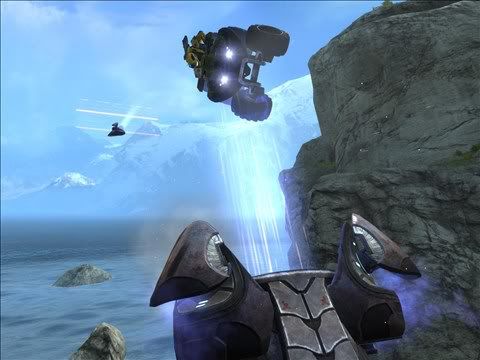
Hitting the 2nd cannon and heading to the 3rd
On the third cannon I had to use two red trampoline shields (one below, one behind) to put around the cannon in case you come up slightly short or long. Through playtesting and tweaking the setup I realized, no matter what I did, the trajectory of your flight is always slightly different each time on this obstacle. The trampolines compensate by making the jumps as consistent as possible and give you a chance to hit the cannon if you're off a little. I was frustrated because I wanted the system to be flawless and simple, but there were anomalies I didn't predict and I just had to build for them when they occured.
When I began to explain the system of launchers around the spire, I said I wanted to create multiple paths but it didn't work. Even though my idea failed in that section I knew I still wanted it to work out somewhere else in the map. It was a situation where I learned that the game will only let you use so many units of each asset, and I need to learn how best to use them. Compromise for the greater good of the level. With all this in mind, shortly after the faithplate section I found a way to create multiple paths and make it work for me.
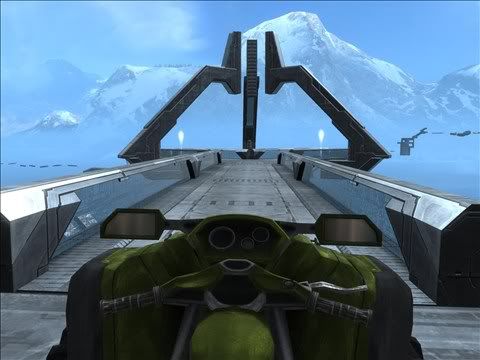
Finally a fork in the road indicative of choice!
You arrive here at the fork in the road via a reciever teleporter after going through the faithplate section, then going through a section where you jump off a ramp and through a sender teleporter. I placed the fork in the road here in this spot because I liked the vista it created when you enter the area through the teleporter that leads to it. The Forerunner architecture I used resembles the shape of the mountain behind it.
I decided that the two paths I was going to create needed to be fair to the player in the sense that I don't want you to feel ripped off for picking a lame one. I wanted them to use the same mechanics, have similar length, and feel, but I wanted them to be a little different. Also, both paths lead to exactly the same place in the end. Here are some shots of the two paths.
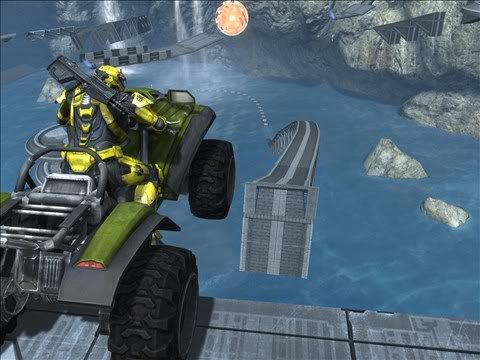
Path A. This is a half of one of the paths you can choose back at the fork in the road. This is another example of the roller coaster influence I wanted. A big plunge to take, speed to build, and eventually you jump a ramp and fly through a teleporter to the other half of the particular path
Path A. A view of being on the larger ramp. At the bottom you will splash through some water that washes over the ramp, then you will begin a dangerous left turn on a smaller piece of ramp. It's difficult but it can be done at full speed, however you will not be punished for taking it at slower speeds
Path A. You can take this ramp at low or high speeds. I established the parameters of the teleporter in such a way that it will let you through even if you come up a little short or under the baseplate. As long as you hit the teleporter you will safely come flying through to the next half of the path. Isn't the waterfall pretty?
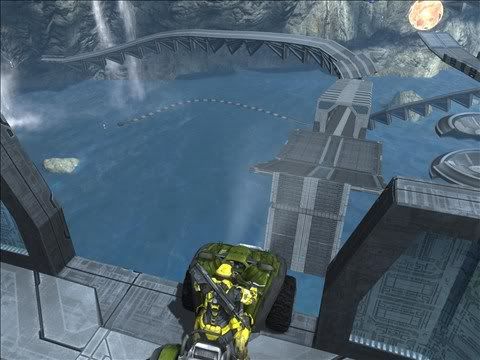
Path B. The other option the fork in the road offers. Similar shape and concept to its counterpart but a little different. A plunge to take, speed to build, and a teleporter to fly through to get to the next half of this path
Path B. A shot of me flying through the portal so that I can reach the next half of the path
Path B. A sneak peek at the second half of the path after you fly through the teleporter. You shoot across ramps and kick up water before you head into a sweet tunnel
Both full paths will get you to the same end, a collection hub, shown below. A funny story about the collection hub, is that at one point, it broke the level. Remember earlier when I showed you the fork in the road with the mountain peak in the background? That setpiece was originally built above this collection hub, and it was close enough in distance that you could get off the mongoose, jump down to the collection hub, and bypass an entire section of the level (the two fork in the road paths). I laughed when I noticed the blatant loophole, but I stopped laughing once I realized I needed to reposition the entire set piece and fix the loophole. It took a little while but it got done. Fuhgettaboutit!
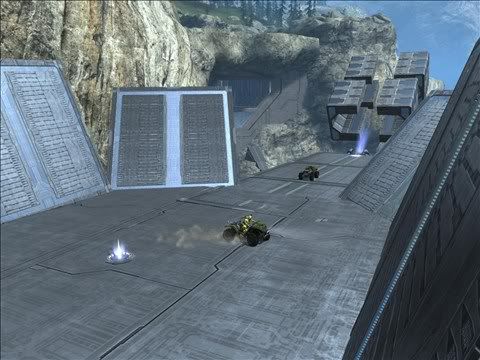
The reason I put up walls was because the two paths that will both ultimately get you here, do so very quickly and you come flying through the teleporter just like I am in this picture. Luckily, the speed won't cause you to hit the walls and die. Already another jump can be seen just beyond the collection point in front of the second Mongoose
After you come flying into this hub you will have to get ready for another jump. It is in fact the final vehicle jump, and my favorite:
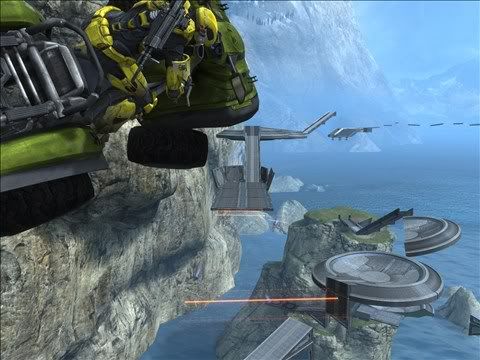
I like this jump because it's too long to make alone, so along the way you hit a red trampoline shield and bounce a bit to yet another trampoline, and from that second shield you will bounce safely to your destination
The final jump shown above is my favorite because it's fun to experience, sends you flying quite a ways, lets you bounce around, and ultimately you land safely and get to look back and say "That was pretty fucking cool". Those are the words my friend Justin used when I was letting him playtest it. I was watching him and taking notes, so in my notes it says "Justin: Omega jump: pretty fucking cool!". This final jump is also the most consistent part of the whole level. I'm not sure why, I didn't put more time into it, it was just luck. I've tried everything to break it or find inconsistencies but whenever I play it or my friends play it, everybody has exactly the same jump as the next person which is nice seeing as it's really fun.
The only reason it is the final jump is because I ran into another harsh learning lesson. I was building the setup for the jump and realized I was finally out of mancannons to use and there was only a few thousand dollars left in the budget. In Forge you have a $10,000 budget and each asset costs anywhere from $10 to $500 I think. I didn't keep that in mind and I just kept building naiive and oblivious to the restrictions. I was hellbent on filling the entire map up with shit to do. I had more ideas than the budget would ever allow. So noticing I was nearly broke, with my remaining budget I decided to make a small platforming section because I didn't have the resources to make a fun driving section anymore. I could've kept building ramps and track, but it wouldn't fit in and live up to the previous driving sections. That's not good enough.

Beginning of the platforming section. It's such a piece of junk that for the longest time I didn't even have a section for you to drop off your mongoose. My friends and I were dying everytime we stopped on the path and dismounted the vehicle. Not enough room on either side to step off the mongoose and onto solid ground. Now I finally have a platform to drop them off
When I changed gears and starting focusing on platforming I just wanted to make pure jumping the focus. There's not a lot of mechanics I could think of that would make it more than jumping from point A to B. In Forge I couldn't create any fully realized buildings with working doors, puzzles, cinematic events, and other things I love about platforming and exploration in FPS games. If I could I would just make a whole Portal game, but I couldn't with these tools. So in OC1 I had to settle for focusing on pure jumping, and exploit the Halo mechanics and assets to serve my purpose. The only skills I require the player to be able to do are crouch, jump, and the old Halo "crouch-jump" (jump and then crouch in the air to help you get to an area that's too high for a normal jump).
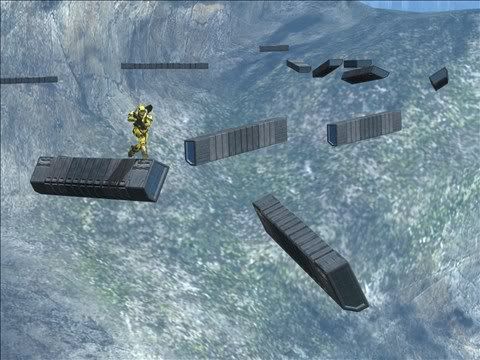
The whole beginning of the platforming section looks like a trainwreck, literally. The platforming works well though, and it's cool to see the ocean below you as you make your way around
A nice shot with a mountain peak in the background. This sequence can be done at full speed: run, jump, jump immediatly off the small pillar, and let your momentum carry you to the platform on the right
Eventually I stopped the path of planks and started using buildings and other structures as obstacles:

A system of staggered jumps that get you to the roof of this particular building asset. The buildings and assets themselves all became obstacles. I want you jumping and studying the environment around you, not just cruising around stairwells with nothing to do, and no challenge
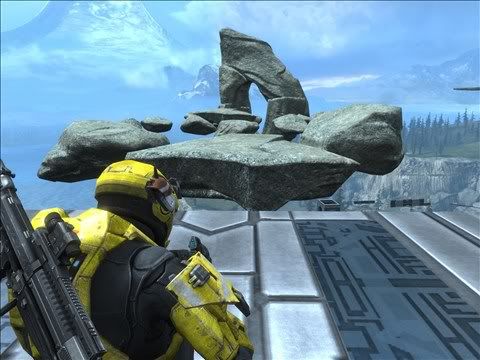
During playtesting my friend said it would be cool to see a bunch of rocks floating in the sky, and be able to jump around between them. I implemented his concept the next day and decided he had a great idea not only aesthetically but from a gameplay perspective, so it stuck. Friends come in handy. In this set piece there are many rocks of different sizes and shapes placed around the sky. Some jumps are easier than others, but there's no dead ends. It's up to you to choose your path. The goal is the giant rock vagina at the end
Taking a leap of faith across the abyss and into the giant rock vagina
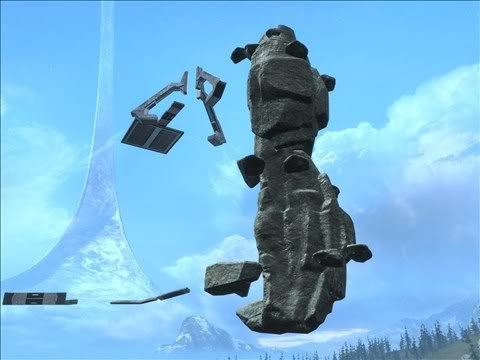
The final obstacle of the platforming section. I call it the "Rock Deuce" or "Rock Turd". You start at the bottom and ascend it. You ascend the rock turd and get ever closer to glory. Classy.
It was at this point I was trying to find effective ways to use the last few dollars I had in the budget. I needed to end the damn thing, and finish this platforming section with a bang. I ended it in the most glorious way I could afford to. Lol
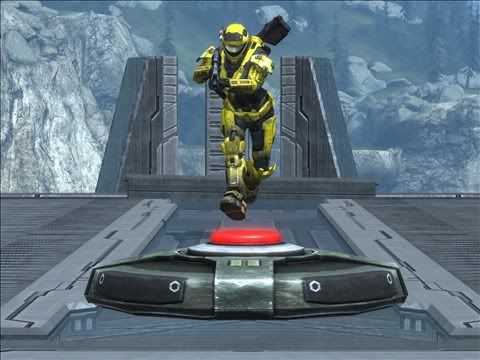
On her way to glory. On a side note do you like my sexy lady Spartan I created? Black, gold, and inspired by Bumblebee from Transformers. She has all the aesthetic greatness of Bumblebee but luckily doesn't have to sit through Megan Fox's attempts at acting
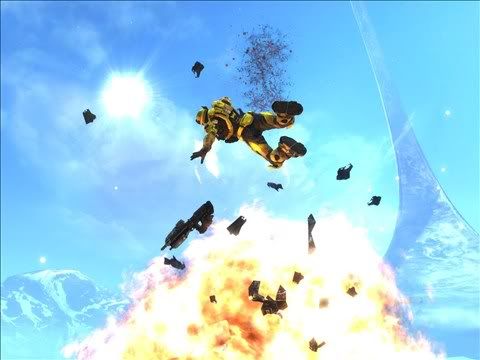
Glory!
As for my workflow, OC1 wasn't work so I didn't spend all day and night crunching at it. Building things in Forge became my video game experience. Instead of settling in before bed and playing a campaign for an hour or two before I go to sleep, I would go into Forge and engage in this experience I was enthralled by. In the end I spent around 8 hours building OC1. At an hour or so a day it took me about a week altogether. The level itself can take around 15 minutes if you blaze through it without dying. More likely it will take 25+ minutes for most players.
Creating OC1 gave me some confidence because I started out with no clue how to use the editor, quickly learned my way around it, and built a place in a game that I enjoy escaping into, and showing off to everybody. The part that inspired me the most was that I realized I have far more ideas and imagination than Forge has resources. No disrespect to Bungie, because Forge is only meant to be a limited editor for multiplayer maps. I tried to use it to make fully realized single player and co-op levels with mechanics in mind that are wildly different than what Halo offers. I strived to reach the stars and in the process I learned that there's a budget to keep, plans to make, lessons to learn, science that needs to get done, and testing to do.
Did you know? The science ALWAYS gets done. We do what we must, because we can
Before OC1 I had no idea what I wanted to do with my life. Because of my experience I was inspired to start planning how I'm going to learn the skills I need, and what I ultimately want to do in my gaming career. I'm at the very beginning of this process and what will become a life journey I suspect. I don't have a big ego or image to maintain so I have no inhibitors keeping me from saying I'm honestly very scared. I have no idea if I will fit in or have good enough ideas, but at this moment there's nothing I want to strive for more than being a great level designer, creating games I want to play, and making a living doing something I love. I have plenty of skills to learn, and a body of knowledge to build, but at least I'm passionate, inspired, and willing to shoot for the stars even when I'm alone, scared, and unsure of what I'm doing. Little experiences and events like OC1 are small and insignificant in the grand scheme of things, but they are small steps in the right directions.
One step in the right direction means one step closer to world domination, and isn't that what it's all about in the end? Yes, it is.

I hope all my Pixlfriends enjoyed this, and managed to get through it without getting bored, frustrated, or incinerated. OC1 was my first creation, but not my last. My next entry in the Forge World Diary will detail the second Forge World level I made, OC2. Stay tuned if you want to see if I took the lessons I learned from OC1 and used them to make OC2 better than its predecessor. So long for now and...
Remember to keep your eyes on the prize. If it's cake, keep your eyes on the cake. If it's world domination, so be it.


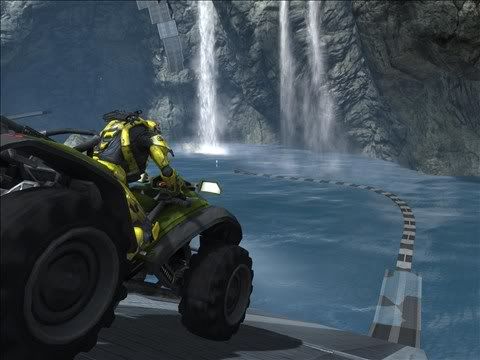
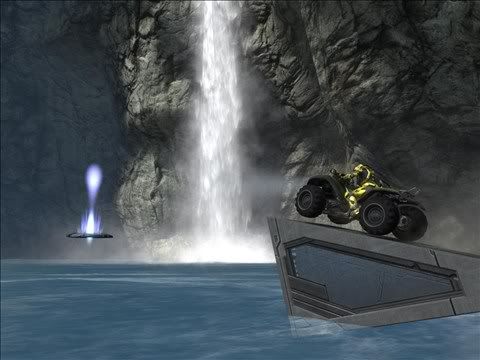

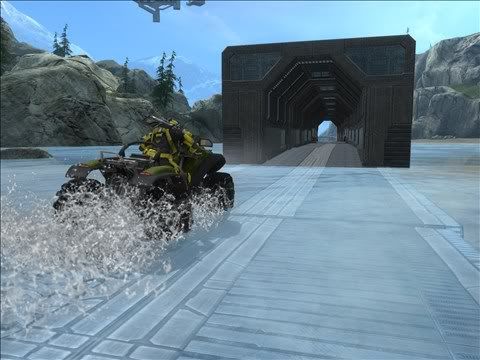




Comments